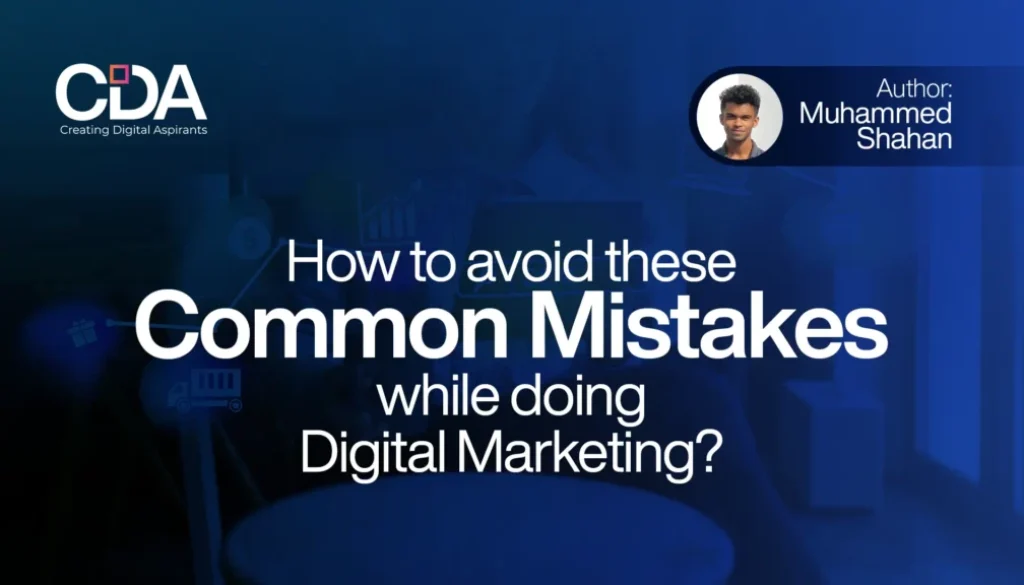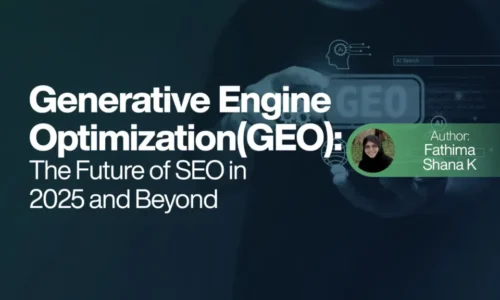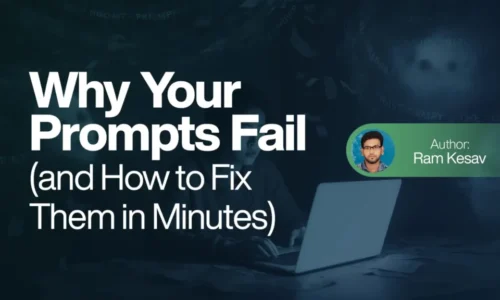How to Avoid These Common Mistakes While Doing Digital Marketing?
Very long time ago, in a world of digital marketing so very active, I was a fresh newcomer with full energy and creative ideas. With my laptop and dreams of how well I would succeed, I left to conquer the digital world. But, as any adventure hero can say, nothing runs just that smoothly from the start. In my case, here were some mistakes created into great learning opportunities.
Mistakes made and lessons learned the hard way. If you are just starting or want to revamp your digital marketing strategy, join me on a journey navigating common mistakes that could derail you from success and explore ways of avoiding them.
Table of Contents

Chapter 1: The Wandering Road—Lack of Clear Goals
Imagine this: Launched my first marketing campaign like a kid in a candy store. MYP: “Just get it out there!” Weeks went by and so did my followers, though they kept increasing, it just wasn’t systematic, kind of like a ship without any compass drifting at sea. My posts were all over the place sometimes with promotions for products and sometimes with memes. Engagement was inconsistent and, at one point, felt frustrated rather than fulfilled.
It had to be dredged up and, in the process, I realized lack of direction was not helping me move forward. It was time to pull out my metaphorical map and chart a course.
The Lesson: In order to market effectively there should be clear goals; otherwise, the tendency is to drift. That’s where the SMART framework became my guiding star:
Specific: Instead of saying, “I want more traffic,” I learned to set specific targets, like “I want to increase organic traffic by 30% in the next six months.” That would be clear for me what I would target for.
Measurable: To see if I was making progress, I established key performance indicators or KPIs. The tracking of these metrics pushed me on course because it motivated me to keep track.
In particular, I start to identify which of my goals were achievable. It is very essential to set challenging yet feasible targets based on my resources and the constraining time available.
Relevant: My targets should contribute to the business mission. I identified what was basically important for the growth of my brand and aimed to ensure that each effort is worthwhile.
Time-bound: The deadlines should be so framed that there is an element of urgency. I made clear time lines to achieve those goals with the help of which I remained focused and accountable.
With the SMART criteria, my campaigns were no longer all disordered efforts but instead carefully thought out strategies. I was no longer a lost sailor; instead, I was possessed of a map for my journey. Result? My marketing efforts started becoming more effective, and thus I experienced tangible results, giving my passion for digital marketing a new life.
Chapter 2: The Mirage of Understanding—Neglecting Target Audience Research
Soon, when I was gaining my footing, the second shock was being administered: my understanding of the audience was hazardously shallow. I thought I knew it inside out. I was itching to introduce a new product and imagined its great orders pouring into the door. But on that day the orders were going to come, I could only hear pin-drop silence. The painful silence in itself felt like a cold splash of reality, once it made me realize that assumptions lead to failures.
I had set my strategies into anchors based only on my preferences and experiences, without considering the special needs and desires of my audience. Confused and disoriented, I knew that I had to regroup and refocus.
What’s wrong:
Assumptions are lethal. Knowing your audience is the one element that makes the content relevant. Here’s how I pivoted:
Surveys: I started speaking directly to my audience, asking them about their preferences, the challenges they are facing, and what kind of content interests them. I use Google Forms, which gives me priceless insights shaping my campaign well in the future.
Data Analysis: I used analytics tools, such as Google Analytics, which track users’ behavior and demographics. That kind of insight gives me a view of what resonates the most with my audience and guides me forward to different strategies.
Create Buyer Personas: With this step, I created detailed profiles of ideal customers for my business. Considering age, interest, and pain areas allowed me to better tailor messaging.
This changed everything about marketing. Since I really knew my audience’s desires and pain areas, I crafted messages that really connected with the audience, and thus shot through the roof the engagement and allowed me to start building a loyal community around the brand.

Chapter 3 The Disaster of the Digital Storefront: A Poor Website Experience
Feeling more confident, I steered my attention to reworking my website. It was a clutter of confusing content with slow loading times. In curating my content, I poured my heart into it but had made it cluttered and confusing, and off the visitors ran from the website. I envisioned it to be a beautiful storefront, but to my visitors, it was a virtual nightmare. They clicked away faster than I could track and left me dejected.
One fateful day, when after a particularly ambitious marketing push, I contemplated looking through my analytics. Here’s when my heart sank because I saw such a crazy bounce rate there. It was as if I’d thrown a party and no one showed up.
The Lesson: A user-friendly website is the only thing that will save your ass from disaster. Here’s how I transformed my disaster into victory:
Optimize Loading Speeds: I used tools like Google PageSpeed Insights to identify which components were causing the slow loading. In simple terms, by compressing images and minimizing code, I improved the web application’s loading speed by a good amount, thereby making it more user-friendly.
Ensure Mobile Responsiveness: Since nowadays most people access web pages from mobile devices, I ensured that my website performed quite smoothly on all devices. Then came the actual activity of ensuring that it appeared just fine on smartphones. Now, this was going to become one of the most important tests in my website development process.
I restructured my website in a way that simplified the navigation and streamlined it so that the end-user could just easily get to whatever he wants. Easy menus and logical classification removed frustration and changed the overall user experience.
Run Usability Testing: I asked my friends and colleagues to go around the site and give me their opinions. Their knowledge was helpful in pointing out things I hadn’t noticed, and I learned how I could enhance usability.
Now that I redesigned my website, everything changed overnight. Visitors began to hang around the website, reading all I offer and becoming decent customers. Seamless user experience not only increases customer satisfaction but also trust in your brand.
Chapter 4: The SEO Abyss—Ignoring SEO Best Practices
Just as I was really getting in the groove, another problem surfaced: I hadn’t touched SEO at all. One day, a colleague just casually brought it up in conversation and mentioned it in passing; I realized my content was solid but essentially buried under a mountain of competition. It is like making a beautiful piece of art and leaving it in a drawer. The overwhelming technical jargon surrounding SEO had paralyzed me into procrastination.
The Lesson: SEO is your best friend. Here’s how I embraced it:
Keyword Research: I dove into keyword research using the likes of Google Keyword Planner. Concentrating on long-tail keywords which focused specific intent on my user just made my content much more visible.
On-Page Optimization: I learned to introduce keywords naturally into my content. Including headings and meta descriptions by understanding that quality content is what matters. So, I stayed clear of the trap of keyword stuffing.
Quality Content Generation: I began posting extremely regularly, generating informative, high-quality content answering the questions of my audience. That alone started building my SEO and puts me in a position to be considered an authority in the niche.
Backlink Building: I began emailing other bloggers and websites, soliciting them to link back to my content. Guest blogging and forming partnerships significantly increased my website authority.
Actually, I found that all the time invested in SEO turned out to be worthwhile. The results on my site started to appear in the better search rankings; more importantly, I was thrilled to see that newfound visibility and was not focused on numbers; rather, I was connected with the right audience who actually needed my products.
Chapter 5: The Confusing Identity Crisis—Inconsistent Branding
As my confidence grew, I jumped headfirst onto social media, but at one point, the branding was so all over the place. One day I was casual and relatable, while the next day I was too formal and corporate. It was like a movie with multiple twists-you never knew who I really was.
Lesson: Consistency is key. Brand identity is cohesive and builds trust and recognition. I did this by accomplishing the following.
Design Brand Guidelines: I wrote a long document that expresses my brand’s voice, tone, and visuals (colors and fonts). It served as our guide for me and all my team members, but also for our collaborators, ensuring we were all singing from the same hymn sheet.
Unified Imagery: I always insured that my logos, colors, and fonts are consistent and unified across all platforms so that my brand could be identified very quickly and made possible my identity in the minds of my audience.
Consistent Communication: I presented the same tenor across all communications, be it on any social media post or a newsletter. It made my audience experience a cohesive brand that helped reinforce my identity.
Brand guidelines built a trusted and recognizable identity. They can connect at a deeper level with my brand, and engagement goes through the roof. Consistency is not just some buzzword it is a core cornerstone of successful branding.
Chapter 6: The Data Blindfold—Failing to Measure and Analyze Results
I got involved in execution and was too busy to analyze my results. I did celebrate the small wins, but not in the long run because I did not know which strategy was working. It’s like baking a cake without tasting it-this is delicious in theory but potentially disastrous in practice.
Lesson: Data is a treasure trove of insights. Here’s how to harness it effectively:
I initialized Google Analytics and social media analytics to track performance metrics. I focused more on tracking the sources of traffic, conversion rates, and engagement levels.
Identify KPIs: I identified the key performance indicators in order to be aligned to my goals such as engagement rate, customer acquisition cost and so forth. This focused me on.
Author Info
Muhammed Shahan, a Digital Marketing Strategist based in Kasaragod.
Learner of CDA Digital Marketing Course in Kozhikode.




